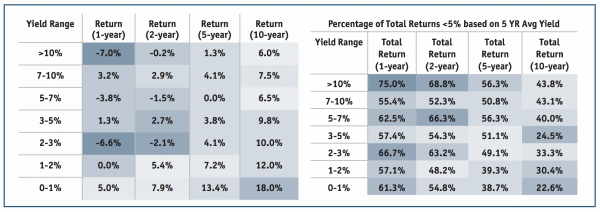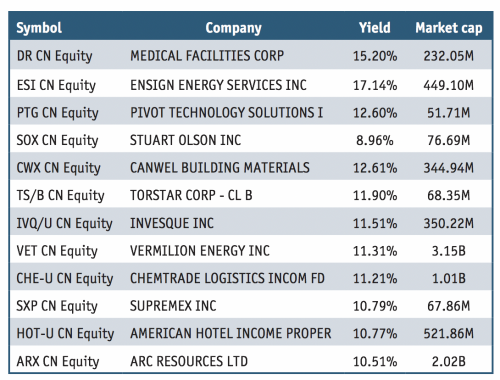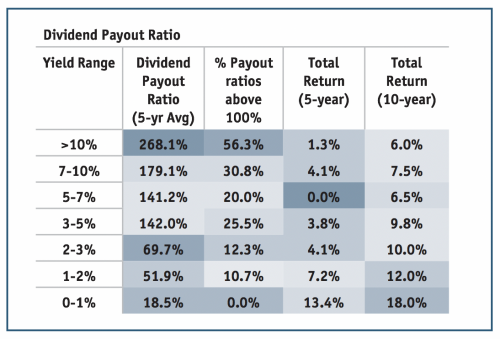Does High Yield Really Mean Higher Risk? YES, YES, YES!
 Most investors, especially astute MoneySavers, know that a high dividend yield usually (though not always) means higher risks. The exception generally comes from “total” market events, such as in 2008, when ALL stocks declined, so those companies paying dividends saw big increases in their corresponding yields due to their rapidly falling stock prices, which was due to market conditions and not company-specific events. For example, some bank stocks yielded 13%, or more, at the peak of the financial crisis.
Most investors, especially astute MoneySavers, know that a high dividend yield usually (though not always) means higher risks. The exception generally comes from “total” market events, such as in 2008, when ALL stocks declined, so those companies paying dividends saw big increases in their corresponding yields due to their rapidly falling stock prices, which was due to market conditions and not company-specific events. For example, some bank stocks yielded 13%, or more, at the peak of the financial crisis.
But generally, if you see a high yield on the stock, don’t be enticed to buy—in fact, you may want to run away. So, while many investors “know” this rule, surprisingly few follow it. Many investors simply “chase yield”. They see an 8%, or a 9% dividend, and convince themselves that, even if the company cuts its dividend to say 4%, that’s still nearly twice what they can get with a safe GIC.
So, they buy these high dividend yielding stocks, or at least, hold onto them if they already own them. How does this usually turn out? Let’s take a look:

Above is a 10-year chart. Looking at the left side, it is clear that the highest yielding stocks are the worst performers in terms of total returns. In fact, over the full study the lowest-yielding stocks returned three times what the high yielding stocks did. Put another way, instead of providing solid returns and income, buying the highest yielding stocks only more or less guarantees sub-par total investment performance.
Recent examples on the Toronto Stock Exchange (TSX) show how devastating owning a very high-yielding stock can be. Just Energy (JE on TSX) was paying a 50 cent annual dividend when its stock was in the low $4 per share price range, for a yield of more than 12%.
The company cancelled its dividend altogether in mid-August, and shares fell 50% in two days. For investors, any “benefit” of the high yield was completely wiped out by the capital loss in the shares (the company also reduced its dividend in 2014, confirming our thesis that the first cut is never the last.)
If investors “expected” a dividend cut though, then why did the stock fall when the cut was announced?
Again, it is that investor illusion again, where, even when investors “think” a cut is priced in, they really don’t expect one (otherwise they might not own it in the first place.)
With the previous chart telling you to avoid high yield stocks, and recent examples in mind, we ran a screen of the highest dividend yields on the TSX recently. Perhaps these are some companies you may want to watch out for if you own them or think about twice if you are thinking of buying. Interestingly, when we ran our screen, some stocks showed up that had already eliminated their dividends, even though our data screen listed them because they did pay dividends earlier this year (such as Dorel Industries, which suspended its dividend in early October.)

An analysis on dividend stocks would not be complete without a look at dividend payout ratios.

In the table above we took the five-year average dividend payout ratio and percentage of payout ratios above 100% for different yield categories.
A payout ratio greater than 100% essentially means the company is paying a dividend that is greater than its earnings, which is a dangerous area for a company to fall into as it often means taking on debt or depleting cash reserves just to pay a dividend. In most cases this should be viewed as a red flag. Of course, there will be outliers that skew the data when looking at averages, but what we can safely say is the more dividend-focused a company is, the more it may put itself at risk in stunting its growth (from having less room to reinvest) and even worse, not being able to maintain its dividend. The table above shows the dividend payout ratio and percentage of payout ratios above 100%, as well as the 5- and 10-year average total returns to link the main pieces of our study together.
This is an interesting implication. If we are owning dividend stocks for “safety” we might be getting the opposite result the higher in yield we go. Since higher yields typically also mean there might be something wrong at the company, or the payout ratio by default might be high (regardless of any other issues), as we noted in the first part of this article the dividend itself for higher yields might be higher risk than other names with lower yields.
From our findings, one general concept that can be inferred is that high yielding stocks often have a high yield for a reason, and that reason is often a compensation for higher risk. Some of these risks include a company being too leveraged or incurring losses but continuing to pay a dividend as compensation for investor patience.
Unfortunately, many companies get stuck in a vicious cycle of paying a dividend they cannot afford while not wanting to cut it back out of fear of losing investor confidence. This in turn leads to higher payouts from earnings which could be used instead to grow and maintain the business. Due to this potential dilemma, many well-known growth investors prefer companies that hold off on paying a dividend and see more value in a company reinvesting earnings into R&D and capital expenditures to expand the business and strengthen competitiveness. For a capital growth-oriented investor, even the positive effects of reinvesting dividends (through say a dividend reinvestment plan) would not be as appealing because they would rather see those dividends reinvested into the company’s operations than to shareholder’s equity on the balance sheet.
So, what implications does this have on the actual investment process? Ultimately, we think this depends on your time horizon, risk tolerance and your overall investor type. ‘Income investors’ typically don’t mind lower potential total return and would rather have the yield. Ideally, this investor will look for mature blue-chip companies that pay a consistent (hopefully growing) dividend.
For the income investor type where that investor is willing to forego total returns for something that helps them meet ongoing cash flow needs, we think a good place to look is that “sweet spot” of yields of between 2% and 5%. Many companies in this category have shown a reasonable total return for the yield they offer. On the other hand, an investor that just wants an optimized return should consider tilting a portfolio more to low yielders.
Any income needs could be satisfied through simply selling holdings which typically is also a more tax-effective strategy than income or dividends. This tilts the portfolio more to companies that have not only generated higher total returns on average over the last five and ten years but also skews the probabilities more in favour of the investor. Since more companies tended to have above average returns at lower yields, the investor “plays” in a space where the odds of winning might be higher. We think the clear takeaway, however, is that high yielding stocks are often more of a distraction and while the idea of the juicy yield is enticing, the odds are that it is not worth the added risk.
Peter Hodson, CFA, Head of research at 5iResearch Inc, an independent stock research company, research@5iresearch.ca, www.5iresearch.ca.
Moez Mahrez, CFA, Investment Analyst at 5i Research Inc., Waterloo.

